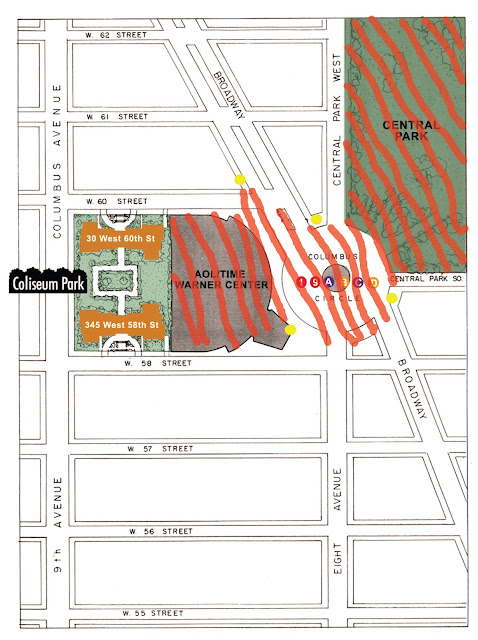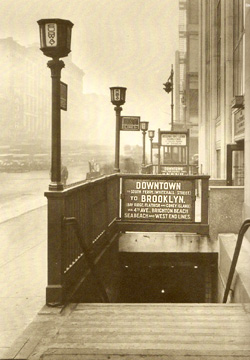Tuesday, May 31, 2011
Columbus Circle: Subway Station & Activity Zones
The New "Circle"
A century after the Columbus Circle was first completed, much political debate seized after the erection of Lincoln Square. The Lincoln Square addition further developed Columbus Circle allowing 23 thousand visitors, 33 thousand students, 232 fashionistas, 37 thousand employees, and 24 thousand residents to eat and shop. The construction of the Time Warner Center also provided for improvements of the subway and public spaces.
 |
| photo by Mark Fink |
A century after the Columbus Circle was first completed, much political debate seized after the erection of Lincoln Square. The Lincoln Square addition further developed Columbus Circle allowing 23 thousand visitors, 33 thousand students, 232 fashionistas, 37 thousand employees, and 24 thousand residents to eat and shop. The construction of the Time Warner Center also provided for improvements of the subway and public spaces.
 |
| photo from Christian Heeb Photography |
Monday, May 30, 2011
The Original Columbus Circle
After Columbus Circle's full development of entertainment spots, office buildings, and homes, the area begin to have its share of issues. One major complaint was that Broadway, and Columbus had become known as "streetwalkers' stroll." As a result, the New York State Legislature assigned Robert Moses' Triborough, Tunnel, and Bridge Authority to develop an exhibition hall. The city and Authority then designated the site between 58th and 60th Streets, Columbus Circle and Ninth Avenue, for Title 1 of the Federal Housing Act as "slum clearance". Under this law, over half the site had to be for housing. Placed on the rest of the site was the Coliseum which in 1986 became New York's Convention Center.
The picture above shows an original image of Columbus Circle before the subway was created. Here one can see a number of trolleys providing access to the circle. It may have been an idea to replace those trolleys with the subway station.
 |
| This is a photo of Wikimedia Commons. |
After Columbus Circle's full development of entertainment spots, office buildings, and homes, the area begin to have its share of issues. One major complaint was that Broadway, and Columbus had become known as "streetwalkers' stroll." As a result, the New York State Legislature assigned Robert Moses' Triborough, Tunnel, and Bridge Authority to develop an exhibition hall. The city and Authority then designated the site between 58th and 60th Streets, Columbus Circle and Ninth Avenue, for Title 1 of the Federal Housing Act as "slum clearance". Under this law, over half the site had to be for housing. Placed on the rest of the site was the Coliseum which in 1986 became New York's Convention Center.
The picture above shows an original image of Columbus Circle before the subway was created. Here one can see a number of trolleys providing access to the circle. It may have been an idea to replace those trolleys with the subway station.
Sunday, May 29, 2011
Before the "Circle"
Columbus Circle, the first roundabout, was designed by William P. Eno, creator of the stop sign and road safety pioneer. Columbus Circle was included in Olstead's design of Central Park as a grand entryway of what was planned to be one of the largest parks in the world at that time. In the early 1900's, planners hoped for Columbus Circle to be the entertainment center of New York. By the 1920's, there were theatres, movie houses, and other places for entertainment. Prior to 1905 when the circle was completed, it was buildings such as those as well as office buildings and cafes that helped to shape the area. Since Columbus Circle was intended to be the grand entrance of Central Park, it was important for a subway station to be centered there in order to provide patron with access to the main entry of the park.

Source:

Source:
Bookhout, Polly. "Coliseum Park Apartments." n.d. <http://www.coliseumtenantscorp.com/history.html>.
Friday, May 27, 2011
Columbus Circle

Columbus Circle located at the intersection of Eight Avenue, Broadway, West 59th Street, and Central Park West is a significant landmark within the borough of Manhattan. It brings together the neighborhoods known as the Theatre District, Upper West Side, and Hell's Kitchen. The statue of Columbus was erected in 1897, but the circle itself was not completed until 1905, and was renovated, a century later, into what it is now.
This photo is taken from one end of the activity zone over-looking the rest of the activity. The activity zone is significant in assessing the reasoning behind access points of the subway.
The image above of Columbus Circle is taken from the Lincoln Square showing one of the major corridors - a major vehicular and pedestrian view both into and out of the circle.
(picture from the Wikimedia Commons)
Research Purpose
The focus of my research is to analyze how the presence of subway stops impact the urban transition within these areas as well as how the transitions within these places impact the subway station as a result of the change.
Simply Said:
I am studying four locations in New York City so that I understand how the subway impacts transitions in order to understand how to develop transit oriented developments.
Transitional New York
Over the next few weeks I will be traveling to New York City to analyze the urban reinvention within four areas of the city. Those four areas include: Columbus Circle, Atlantic Yards, Times Square and the Highline. In my research, I hope to analyze what those areas were and what they have become; as well as how the design and layout shapes the specific place into what is it.
Subscribe to:
Posts (Atom)


